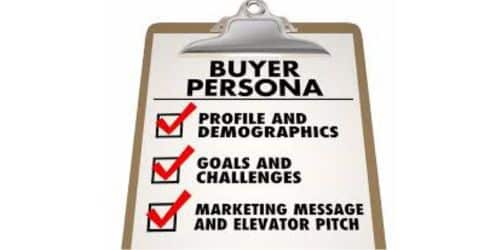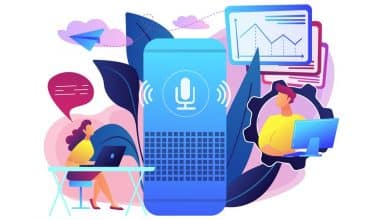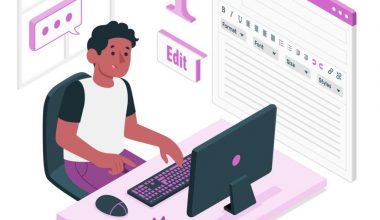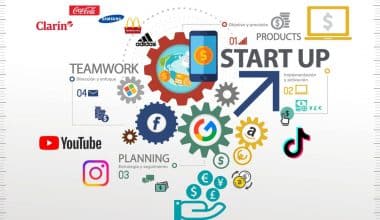A B2B Buyer Persona is essential for finding your target customers and achieving better results from your marketing campaigns. However, the way people buy products or services can differ significantly.
How well do you know your ideal customer? What motivates them? What makes them click and buy your products? The answers to these questions and more make up a Buyer Persona.
As a shopper, there’s nothing better than finding a product that feels made just for you. As a business owner, creating that feeling is one of the best things you can do for your business. When customers feel a product is perfect for them, they are more likely to share it with others, pay more for it, and overlook minor flaws.
Of course, no product is designed for just one person. However, the best products often feel that way because they are designed and marketed with a specific buyer persona in mind.
In this article, we will explain the B2B buyer persona and how to create one, including a few examples to guide you through. By following a few simple steps, you’ll be able to create consumer stories and profiles that accurately represent your customers.
Key Points
- A buyer persona is a fictional profile of an ideal customer based on actual data about their demographics, behavior, and needs.
- A target market is a broad group defined by general demographics, while a buyer persona is a detailed, specific representation of an ideal customer.
- One of the benefits of a buyer persona is that it improves clarity and focus in marketing strategies.
- To create a buyer persona, you must conduct customer interviews to understand their purchasing motivations.
- Regularly update personas based on new data and feedback to keep them accurate and relevant.
What is a Buyer Persona?
A buyer persona is a made-up profile of your ideal customer based on real information about them and how they use your product or service. It is usually shown as a summary of demographic and psychographic information, complete with a fake name and (stock photo) face. This makes it easier to remember and use the persona when making decisions.
These descriptions reflect your different market segments, each with a name representing a specific buyer type. For example, you might have Stylish Jane, Practical Zinny, and Discount Dora in your clothing business. Each one represents a different group of buyers with similar backgrounds and habits.
Stylish Jane is all about looking fashionable no matter the cost. Practical Zinny wants functional and durable clothes, and Discount Dora only shops during sales and helps clear out last season’s items.
Read Also: CUSTOMER PROFILE: Meaning, How to Build & Use Them
Again, in your electronics store, you might have Techie Tom, Budget Ben, and Eco-friendly Emma. Each one represents a different group of buyers with similar backgrounds and habits.
Techie Tom is always after the latest gadgets and doesn’t mind paying extra for the newest technology. Budget Ben looks for good deals and prefers affordable options. Eco-friendly Emma chooses environmentally friendly products, even if they cost a bit more.
However, personas are more than just fun names. They help you attract more buyers by allowing you to tailor your marketing messages to each specific group.
Personas help you understand what your customers are:
- Thinking
- Feeling
- Worried about
- Hoping for
- Expecting
- Planning
- Believing
Most businesses have several buyer personas, but you can use only a few. Start with a few and add more as you identify different customer types. One to five personas are enough to begin with.
Buyer Persona vs. Target Market
I remember the first time I had to create a buyer persona. It was early in my career, and I was working at a tech startup aiming to enter a competitive market. We had a great product, but our marketing efforts were falling short. It wasn’t until I realized we were trying to appeal to everyone instead of targeting our ideal customers that things started to change. This taught me the concept of B2B buyer personas, and the improvement in our marketing results was incredible.
A buyer persona is not the same as a target market. A target market is a large group of people, often defined by broad demographics or audience segments. For example, a company selling yoga accessories might say, “Our target market is women aged 35 to 45, living in cities, who love yoga.”
On the other hand, a buyer persona is more detailed and specific. For instance, “Our buyer persona is Samantha. She is a 39-year-old engineer living in Austin. She has been attending her local yoga studio for eight years, but now that she works remotely, she’s looking for ways to practice yoga while traveling.”
Negative personas
Just as you identify buyer personas you want to attract; you may also encounter types of customers you don’t want to target.
Negative personas are buyers who waste your time and resources without any intention of buying or with a low chance of buying. These might include, for example, Questioning Quinn, who asks a lot of questions about fit, return policies, and holding items but has yet to make a purchase.
Or Returning Rachel, who buys a lot of outfits and returns them right before the return period ends. You suspect she wears the items, making them harder to resell.
Negative personas hurt your company’s profitability and interfere with serving your ideal customers. So, keep them in mind when creating your marketing messages.
Why create Buyer Personas?
Buyer personas help you better understand your customers, including how they think and shop, so you can create marketing campaigns that really connect with them. Knowing your audience’s details, like age, location, interests, and buying motivations, helps you make your content, messages, and products more appealing.
As the internet gets busier, effective marketing is about speaking to the right people with the right message at the right time.
Buyer personas are a handy resource for you, your team, and anyone you work with, ensuring everyone understands your target audience.
The Benefits of Buyer Persona
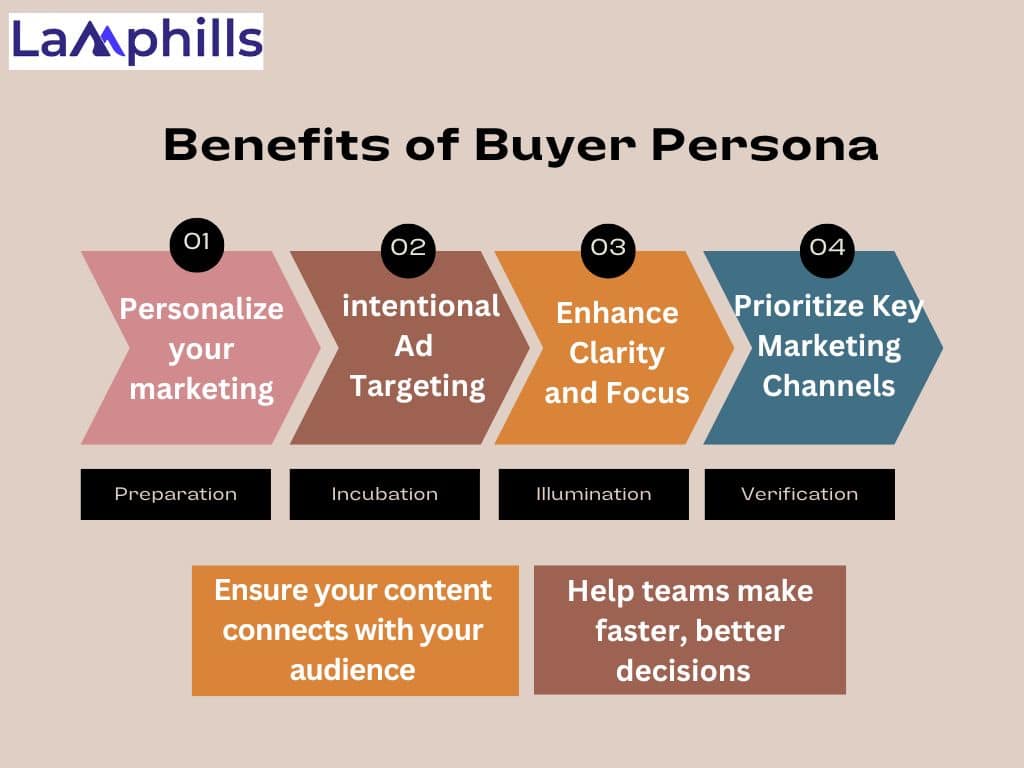
Having a detailed buyer persona allows you to:
#1. Personalize your marketing
Personalization is the main reason buyer personas are essential. You can only personalize when you truly understand your audience. Customers love personalization. In fact, 96% of marketers say it makes buyers more likely to become repeat customers, and 94% say it boosts sales.
I agree with these stats. As a consumer, I’m more likely to stick with and repeatedly buy from brands that know what I like and cater to my interests. For example, if a brand emails me about a sale on a product I want, I’m more likely to become a loyal customer and even recommend it to my friends.
#2. Be more intentional with your ad targeting
New tools for targeting customers let businesses create specific campaigns based on many different demographic and psychographic traits.
Paid advertising now allows exact targeting using information like location, age, language, education level, and interests. You can include, exclude, and combine these traits to show ads to a specific audience, even if you have a small budget and a new online store.
#3. Enhance Clarity and Focus
Creating buyer personas helps businesses better understand and talk about their customers. By summarizing what they know about their customers into a single, fictional person, businesses create a shared understanding of who they’re serving.
This often becomes part of the business’s internal language. For example, a buyer persona might help a yoga company shift from asking, “How do we reach more women who love yoga?” to the more specific, “How do we reach more people like Evelyn?”
#4. Prioritize Key Marketing Channels
A common mistake in marketing is trying to be everywhere, which can spread your time and resources too thin. When you know where your target customer spends their time, it’s easier to decide which channels to concentrate on and which ones to avoid.
#5. Ensure your content connects with your audience
When you understand your audience, you can create headlines that grab their attention, use images they relate to, and make content they find helpful, fun, or motivating. By targeting your audience based on where they live, their industry, and their interests, you can increase the chances that your brand reaches and resonates with the right people.
#6. Help teams make faster, better decisions
Your research to understand your customer shouldn’t be kept in one person’s mind or scattered across many documents. A buyer persona profile puts all the essential information about your target customer into one or two pages. This way, everyone in your business, from marketing to support, can use it when interacting with customers.
For example, support teams can now predict problems that might prevent customers from buying, like the need for certain skills to use the product or the inclusion of another language to make things easier for customers.
Note: Your customer personas will change over time. When you create personas for a new business, you might start with general market and industry research, as well as your thoughts and guesses. As you learn more about your customers, remember to update your personas with new information and feedback from your interactions.
How to create a buyer persona in 8 steps
You can make buyer personas by doing research, surveys, and interviews. Talk to potential customers and people who fit your target audience but have not been in your contacts. Ensure your buyer personas are based on facts about your audience’s interests, behavior, and demographics. Here are simple steps to create a buyer persona:
#1. Talk to Your Current Customers

Image by Sasin Tipchai from Pixabay
Start by making a customer profile by first talking to your customers. If you already sell products, begin by chatting with your satisfied customers. This is a crucial step; don’t skip it. You may have ideas about who your customers are and why they choose your products, but you won’t really know until you ask them directly.
You can ask many questions to build a detailed customer profile, but you must ask these four questions:
- Why did you choose our product? This tells you why customers make their purchases, helping you understand their reasons.
- What other options did you consider instead of us, and why? Here, it’s important to ask about other options, not just competitors. Sometimes, what people consider as alternatives might not be another similar product but something completely different, like a do-it-yourself solution or an unrelated product.
- Where did you look for information before making your purchase? Understanding where your customers get their information can help you focus your marketing efforts.
- Why did you buy the product now instead of earlier or later? This will help you identify the key moments that led to a purchase.
These questions focus on the customer’s buying process, not just their general interests or other purchases. While general customer data is valuable and can be gathered through market research, the main goal of creating a customer profile is to clarify how you can specifically help and appeal to this person.
If you aren’t selling yet, try talking to customers about products similar to what you plan to offer. Be careful about talking only to “potential customers” who say they might buy your product once it’s available, as the most valuable insights come from those who have already made a purchase.
#2. Conduct Thorough Market Research
This means gathering data from various sources, such as industry reports, market surveys, and competitor analysis. After talking to your customers, you can learn more by looking at broader data. Check the information you have on your website or social media pages, look at research about your industry or market, and see what kind of people your competitors focus on. This helps you understand what your audience likes, what they aim for, and how they live their lives.
We initially skipped this step during the tech startup, thinking we knew our market well enough. Big mistake! Once we began market research, we found insights that drastically changed our approach. For example, we learned that our target decision-makers were not just tech-savvy managers but also traditional executives who valued long-term relationships and reliability over the latest features.
#3. Define broad buyer personas
You can identify your main customer profiles after talking to your customers and doing market research. You’ll start to see common traits, likes, buying habits, and characteristics among them.
Begin with broad categories and then get more specific. It’s common for businesses to have several different customer profiles so that you can split these into separate groups. For example, imagine you have an online bookstore called “Readers’ Haven.” Here’s how you might begin to define broad buyer personas for this business:
After gathering data from customer interviews and industry research, you might identify two broad categories of customers for Readers’ Haven:
- Individual readers. People who buy books for personal enjoyment or education.
- Institutional buyers. Organizations like schools, libraries, and companies that might order books in bulk for educational purposes or corporate libraries.
With these two main groups identified, you can further divide them into more specific personas:
- Young adults looking for the latest fiction and fantasy series.
- Professionals seeking books for career development and skill enhancement.
- Educators looking for academic texts and bulk supplies for classrooms.
- Corporate buyers interested in purchasing motivational and leadership books for employee development.
Once you set up these broad customer profiles, it’s time to dig into more specific details about each group.
#4. Identify Key Details About Your Customer Profiles
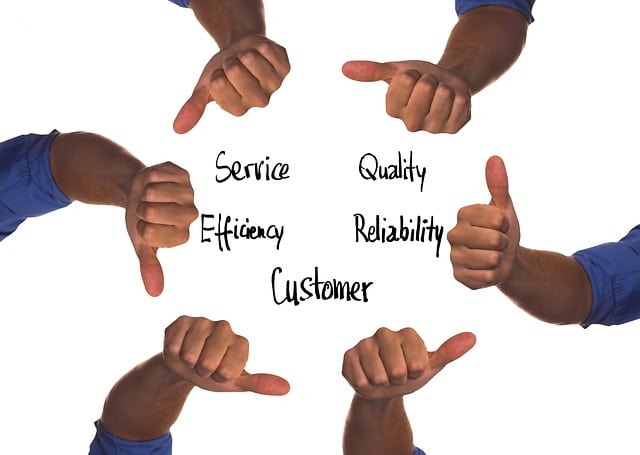
Image by Gerd Altmann from Pixabay
There are many ways to gather customer information, but focusing on details helps you make business decisions. You don’t need to know minor things like a customer’s favorite color or Starbucks order to sell dog food.
Facebook, with its large advertising network, offers many tools for targeting specific audiences. These tools can help you figure out important details about your ideal customers, like their demographics and interests, which help create customer profiles.
Here are some typical details included in customer profiles:
- Location: Where do they live?
- Age: How old are they generally?
- Gender: What gender are most of your customers?
- Interests: What hobbies or interests do they have that relate to your product?
- Education: How much schooling have they had? What did they study?
- Job title: What kind of work do they do, and what are their job titles?
- Income: How much do they earn, and what can they afford?
- Relationship status: Are they single or married?
- Language: What languages do they speak?
- Favorite websites: What websites do they visit related to your products?
- Buying motivations: Why do they buy your products?
- Buying concerns: What might stop them from buying your products?
Remember, you don’t need to discover all these details for each customer profile. You might choose different questions that are more relevant to your business. The main goal is to understand your customers better so you can communicate with them more effectively.
#5. Research your buyer personas
After identifying two or three main customer profiles, it’s time to do more research. This next research phase differs from the first one, where you might have talked to customers and looked at general industry trends. Now, you need to focus more on understanding what drives and influences the customers you have identified.
This step is more about learning why your chosen customers decide to buy and their deeper preferences and behaviors.
Data is very useful because it can give you many insights into what your customers like and do. The more customers you have, the more you can learn from your data. However, it’s also very valuable to listen directly to what your customers say about their preferences.
If you use tools like Facebook Insights or Adobe Analytics, you can discover interesting details. These tools can show you things like the languages your customers speak, the web browsers they use, how they found your store, their ages, and genders, whether they are visiting for the first time or coming back, how often they visit your website, how long they stay on it, and the devices they use to browse.
Facebook Audiences
If you’ve been selling on Facebook and building a group of followers there, Facebook Audiences is a good tool for learning more about them.
Besides looking at the people who already follow you, this tool helps you understand and create groups of potential new customers. It gives you detailed information about their backgrounds and lifestyles.
Your Competitors
Another way to learn more about your customers is by looking at your competitors, especially if your business is just starting.
SimilarWeb is a free tool that allows you to see how many people visit your competitors’ websites. This can help you understand who their customers are.
Market Explorer by SEMRush is a paid tool that helps you examine the leading companies in your industry and learn about the people who engage with your competitors.
You can also check out your competitors’ blogs and social media pages. Look closely at the people commenting and interacting with their posts. You can click on their profiles to learn more about them.
Surveys and Customer Feedback
It’s always good to have numbers, but if you want to understand what makes your customers tick, you should talk to them.
A great way to do this with many people is to use a survey tool like Survey Monkey or call your customers who might buy from you.
Since they’ve bought from you before, finding out why they bought and what worried them can help you talk better to others like them.
Customer surveys are a great way to ask more profound questions and understand your existing customers. Apps like Fairing allow you to send surveys after they make a purchase.
You can also offer free shipping or gift cards to get more people to take your surveys. This method is especially effective for asking why customers buy, like “Would you recommend our business to a friend? If so, why?”
Customer Support
Who understands your customers better than the team that always talks to them? If you lead a team, chat with your customer support or sales team about what troubles customers, what they want, and how they usually behave. This can provide insights about your customers when they decide to buy.
Most customer support systems keep records of all conversations and gather feedback on how happy customers are. Looking through these conversations to find common problems and patterns can help you understand important details about your customers, like what obstacles or issues they face.
#6. Combine Everything into a Customer Profile
With all the research you’ve done, both numbers-based and detail-oriented, you’re ready to compile it into a complete customer profile. You can use a free template to help organize the information you collect.
You’ll find an example for Sally’s Dog Food on the template, but you should fill it out with your ideal customer and the essential traits you need to include.
#7. Double-check Your Customer Profiles
After you’ve created a customer profile, there’s one more important step. Look back at the list of customers you’ve talked to and ask yourself: Does the profile you made match some of these customers? Are these the types of customers you believe you can serve well? If your answer is yes, your customer profile is ready.
I once created a persona that seemed perfect on paper but didn’t resonate with our sales team. After a few discussions, we realized we had missed a critical factor, which is the importance of regulatory compliance in our industry
#8. Use Your Buyer Persona to Make Business Decisions
Once you have a clear buyer persona, you can make marketing choices focusing on your ideal customer. Take, for example, a persona named Emma, a fitness enthusiast. Here’s how you could use this persona to guide specific marketing strategies on Facebook:
- Target audiences on Facebook who have interests related to fitness, such as gyms, yoga, and healthy eating.
- Create engaging Facebook ads that showcase fitness products or services Emma would love, like workout gear or online fitness classes.
- Post content on your Facebook page that Emma would find valuable, such as workout tips, healthy recipes, and motivational quotes.
- Host live workout or Q&A sessions on Facebook to engage with Emma and other fitness enthusiasts.
- Run Facebook promotions or giveaways for fitness-related products to attract and retain Emma’s interest.
- Join and participate in Facebook groups related to fitness and health, where Emma might be a member, to build community and trust.
As you can see, knowing your buyer persona not only helps you choose the right channels and strategies but also guides you in communicating effectively with your ideal customer.
Use a Buyer Persona Template
Use a buyer persona template to make it easier to create profiles and ensure you include the right details for each persona.
Here are some essential details to include in your template, using “Zoe the vet” as an example:
- Name: Zoe, the Veterinarian
- Age: 30 years old
- Language: English
- Location: US
- Education: College degree
- Income: $70,000
- Relationship Status: Single
- Job: Veterinarian, owns her clinic
- Role in Buying: Makes all buying decisions
- Biggest Challenge: Finding high-quality and affordable dog food to sell
- Goals: Plans to open another clinic next year
- Online Habits: Uses Instagram and TikTok, but not LinkedIn
- Favorite Brands: BarkBox and Whole Foods
- Likes Watching: Videos of cute dogs and cats
You can give your persona a name and use a photo to make it more realistic, but the details are what really matter. By knowing who they are, what they do, and what they need, you can create marketing strategies that really connect with them.
Below is a template to guide you through the essential information to build a clear picture of your target audience.
The best part is that by creating a detailed buyer persona like “Zoe the Veterinarian,” you can now market more effectively to thousands of similar customers because you’ve taken the time to understand them better.
Examples of Buyer Persona
Buyer personas can be simple, usually fitting on just one page. This page has all the important details about them. Below are three examples of different personas, filled with key information from talking to customers and researching the market.
Example 1: Online Yoga Accessories Store
- Name: Rita Barns
- Picture: (A stock photo of Rita)
- Age: 39
- Job: Engineer at a mid-size tech company
- Lives in: Central Austin
- Income: $140,000 a year
- Family: Lives with her partner of nine years; no kids; has one dog
- Media habits: Listens to podcasts from tech leaders; uses Facebook (only groups); active on Instagram
- Buys for: Loyalty to brands; like stores with many options
- Buying frustrations: Wants dependable products
- Research methods: Gets tips from yoga teachers; searches on Instagram and Google
- Other options: Might keep using her old yoga gear (“Do I need a new one?”); might buy gear recommended by her yoga teachers or sold at her studio
- When she buys: At the start of a new year or before going to a yoga retreat
- Other favorites: Yoga mat from Lululemon, Peloton bike, hiking gear from MEC
This example shows Rita’s details, helping the store understand her needs and how to market products to her.
Example 2: Local juice and smoothie bar
- Name: Stan Bush
- Picture: (Use a general stock photo of a person)
- Age: 28
- Job Title: Brand Manager
- Where He Lives: Mission District, San Francisco
- Income: $87,000 a year
- Relationship Status: Single, dating
- Likes Using: Instagram, BeReal, group chats
- Why He Buys: Enjoys being part of the community and supporting local businesses
- Shopping Frustrations: Dislikes high-calorie juices/smoothies and the cost of buying them often (He’d visit daily if it were cheaper)
- How He Finds Places: Uses Google Maps to check ratings (won’t visit if under 4.5 stars), listens to friends’ recommendations
- Other Options: Another juice bar nearby, or making drinks at home
- When He Buys: Usually before or after work or around gym time
- Also Shops At Rainbow Grocery, Equinox, Sweetgreen
This profile helps us understand how the product fits into Stan’s daily life, which is especially important for businesses with physical locations.
Wrap Up
Creating detailed B2B buyer personas can transform your marketing efforts. You can make your strategies more effective by knowing who your audience is, what they need, and how they behave.
Remember, your buyer personas may change as you learn more about your customers, and you may find new types of customers as more people learn about your business.
Finally, keeping your buyer personas updated makes it easier for your team to decide who to focus on and how to talk to them. Using these personas can lead to more people interacting with your social media posts and better results from your online ads.
Frequently Asked Questions
What elements are included in a B2B persona?
A buyer persona is a set of details about your target customers, including who they are, what they do, and what they want. Here are the main parts:
1. Demographic Information: This is fundamental information about a person, like their age, gender, income, where they live, and what language they speak.
2. Firmographic Information: This includes details about the company they work for, such as its size, industry, and location.
3. Psychographic Information: This is about their attitudes, values, interests, and behaviors.
All this information helps you understand the roles, needs, and goals of your target audience in an organization.
What is a buyer persona template?
A buyer persona template is a simple tool that helps you describe your ideal customers. Many free buyer persona templates, such as those from Venngage, come in different styles that are great for presentations. Here are some of the best and most useful templates for different business needs.
What are the 4 types of buyer personas?
Buyer personas help you understand and attract different types of customers based on where they are in their buying process. There are four main types of online buyers: Competitive, Spontaneous, Humanistic, and Methodical.
What are the six types of buyers?
According to Brian Tracy, the author of The Psychology of Selling, there are six types of customers every salesperson should know about:
1. The hesitant customer
2. The confident customer
3. The detail-oriented customer
4. The relationship-focused customer
5. The take-charge customer
6. The social customer
What are the 4 buyer stages?
The buyer’s journey follows the steps people take to become your customers and even after that. It’s divided into four stages: awareness, consideration, decision, and delight.
What Are the 5 Stages of Buyer Behavior?
Here are the five steps people usually go through when deciding to buy something:
1. Need Recognition: Realizing you need or want something.
2. Information and Alternatives Search: Looking for information and different options.
3. Evaluation of Alternatives: Comparing the options to decide which is best.
4. Purchase Decision: Deciding to buy and making the purchase.
5. Post-Purchase Behavior: Reflect on the purchase decision and how you feel afterward.
Similar Articles
PR for B2B Companies: Tailoring Your Approach to Reach Decision-Makers
7 Proven B2B Digital Marketing Strategies for Business Growth (+ Top Agencies)
Audience Targeting: What It Is, Why You Need It and Best Tools to Use
